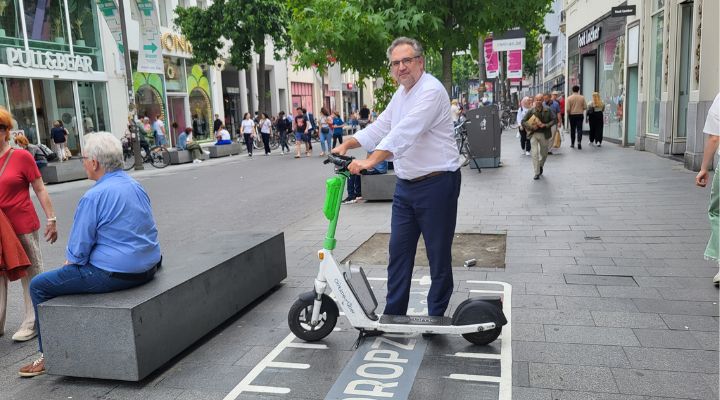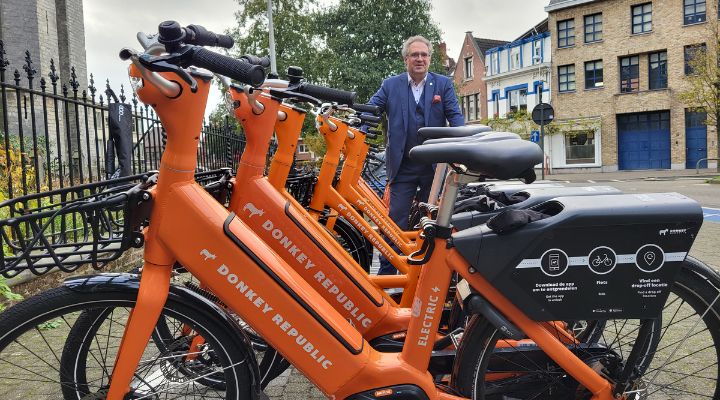Loading component...
Get up to speed on the mobility industry - our newsletter straight to your inbox!
Get up to speed on the mobility industry - our newsletter straight to your inbox!
In the first instalment of our multi-part feature that looks into how micromobility operators can co-exist within the ecosystem of a city authority, we saw things from the operator’s perspective. In the second part we learned how the City of Utrecht works with its preferred suppliers. In the third and final article Intertraffic talks to Koen Kennis, the City of Antwerp’s Deputy Mayor for Mobility about the finer points of his city’s multiple micromobility agreements.
Intertraffic: What does Antwerp, and what do you, look for in a proposal from perspective micromobility operators?
Koen Kennis (KK): When a micromobility operator comes to us, what’s important is that they can contribute to the modal shift in our city. We see it as trying to seduce people into changing their way of thinking about mobility and make it possible that they are using other modes than their own car to travel around the city, whether it's a shared car, or a shared bicycle, a shared scooter, a shared moped or even shared cargo bikes.
Any prospective operators have to follow the rules of the city. We have three aspects that we look for and we have a very strict regulation. One of the things is, for instance, you need to have a good vehicle, a safe vehicle. We check whether the vehicle is robust enough, then we say we want to have a data-driven aspect to check what you are doing. So we ask them to bring data to the city so that we can check whether they are following our rules, because we have also rules concerning the spread of the vehicles in the city, so that it's not only in the centre of the city, but that it's possible to use it in the whole city. We have rules concerning the number of times that a vehicle is used in the city and when it's not used enough, we tell them that they have to diminish the number of your vehicles. Also if operators aren’t complying with certain regulations they receive penalty points – if they exceed a certain number of points they can lose the contract.
We have rules concerning the number of times that a vehicle is used in the city and when it's not used enough, we tell them that they have to diminish the number of your vehicles
Put simply, we can't use vehicles that are standing on the streets and doing nothing, they have to be used. If you want them to be used you have to promote yourself and seduce people into using your vehicles.
Intertraffic: Presumably you are looking for innovative schemes?
KK: Of course, innovation is very important also for us, particularly in terms of data, but also in terms of the vehicles themselves. We have also been innovative and introduced zones where they can't park, zones where the speed of e-scooters is automatically reduced, or even zones where they aren’t allowed at all. That’s interesting innovation, because that helps us to keep to the rules and that in turn helps us to keep people safe in the city. Avoiding nuisance is a necessity for shared mobility to be accepted by the general public. So in this respect the city and the providers have mutual interests.
Intertraffic: How many different schemes have you got, at the moment and what types of micromobility vehicles are in use?
KK: We have a limited number of schemes, a limited number of suppliers that can come in the city. For instance, with e-scooters we now have three schemes running – Bird, Lime and Poppy. We have one cargo bike scheme with Kangaroo. We also have three shared bike schemes, but that's a little bit more complex, because we have incumbents that have been with us for a long time, 11 years in one case. We have first the Velo bikes from Clear Channel. It's a fixed station system, but it works very well. It's one of the best-working shared bike systems in Europe, and I think we have five to six trips a day per bike, which is a lot.
Our Velo bike scheme works very well. It’s one of the best-working shared bike systems in Europe with each bike used for six different trips per day on average
The Velo system consists of 4000 bikes and 305 stations over the city. It started out in the centre only but because of its success over the years we expanded the network over surrounding districts. It is an offer that is perfect to cover shorter distances. In late summer 2022 Donkey Republic e-bikes were introduced in Antwerp, part of a network of more than 2000 bikes in the Antwerp Transport Region [32 municipalities – 1,2 million people] to cover larger distances. This scheme also works very well. We also have a couple of shared car schemes, but we no longer have our shared mopeds as it’s been much more difficult for them. They work extremely well in the Netherlands, but in Antwerp they have such strong competition from shared bikes and e-bikes.
Intertraffic: In our article from the operators’ perspective, it was suggested that they have to “jump through legislative hoops in order to get the green light to implement a citywide trial.” What would those hoops be in Antwerp? What do they have to do in order to satisfy you that their proposal is worthy of even a trial?
KK: We don't work with trials. Prospective operators have to comply with our regulations – for instance, they have to comply with our maximum number of vehicles. With e-scooters, we say we want a maximum 3000 in the city of Antwerp, so when we have three operators, they have to divide that figure between them. The first company in gets a big chunk, and the one who comes in last has to take what’s left. If a new operators comes to us we have to say, ‘wait a little bit, you have to you will see when we renew the concession and then it's possible to come’. 
With e-scooters, we say we want a maximum 3000 in the city of Antwerp, so when we have three operators, they have to divide that figure between them. The first company in gets a big chunk, and the one who comes in last has to take what’s left.
Intertraffic: It’s fair to assume that many people who rent bikes are visiting the city and would likely to be riding an unfamiliar bike in potentially unfamiliar city and yet they are expected to have to fight for road space with trucks and buses and cars. How important is it, therefore, for a city to be able to give cyclists some devoted road space in the form of a ‘micromobility network’? And how would that work in a European city with tight streets around the centre, much of which dates from the 15th Century?
KK: Antwerp has a very well developed network of bicycle paths, measuring 578km in total. A lot of these paths are 100% separated from car traffic, which of course is an enormous asset when it comes to safety. Still, we keep investing in expanding and improving our network. A network is only as strong as its weakest link. e-Scooters have to use our bicycle paths - they have to behave like and be ridden like bicycles. When you are in the historical centre of the city with its narrow streets separated infrastructure is not always possible, you use the streets, along with cars and buses, but we have made many areas a 30 km/h limit and there you can combine micromobility with cars with no problem. 
Intertraffic: What advice would you give to a micromobility operator who was thinking of approaching Antwerp (or any European city) with, let's say, an e-scooter scheme? How defined a plan do they need to have in advance?
KK: Come and talk to the city. As an operator you have to have an understanding of what the city needs and what you can do for them. What are the regulations that the city has in place? What are the rules that the operators have to follow?
Five or six years ago some shared bike system operators came to Antwerp and the bikes were more or less thrown onto the streets with the idea of ‘let’s see what happens’. That was a lucky shot as we could say no, you can't come in the city, because we are busy with regulation. Only when the regulation is there will you be allowed in the city. If you come before we will take all your bikes out, and you can come and get them. And if you don't get them we’ll throw them away. Since then we’ve seen that everybody comes to us and discusses what is possible within the regulations that we have in place. We continuously improve and update the regulations in collaboration and in discussion with the suppliers that we have. These are the problems that we have, how can you solve it? We help them to improve their offering at the same time. We understand each other and in the end we have a good business.
We continuously improve and update the regulations in collaboration and in discussion with the suppliers that we have. These are the problems that we have, how can you solve it?
